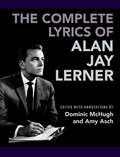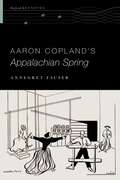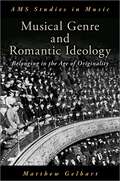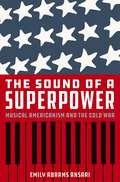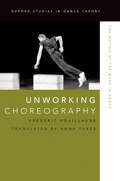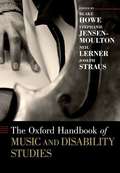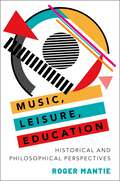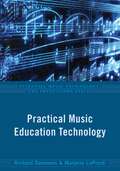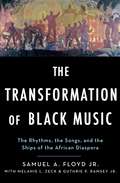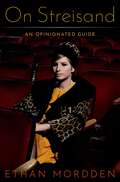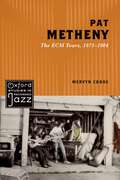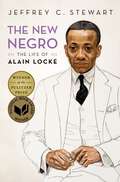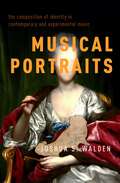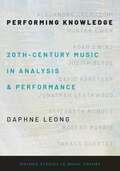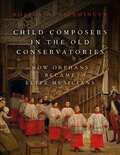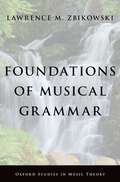- Table View
- List View
The Complete Lyrics of Alan Jay Lerner
by Dominic McHugh and Amy AschAlan Jay Lerner wrote the lyrics for some of the most beloved musicals in Broadway and Hollywood history. Most notably, with composer Frederick Loewe he created enduring hits such as My Fair Lady, Gigi, Camelot, and Brigadoon. In The Complete Lyrics of Alan Jay Lerner, editors and annotators Dominic McHugh and Amy Asch bring all of Lerner's lyrics together for the first time, including numerous draft or alternate versions and songs cut from the shows. Compiled from dozens of archival collections, this invaluable resource and authoritative reference includes both Lerner's classic works and numerous discoveries, including his unproduced MGM movie Huckleberry Finn, selections from his college musicals, and lyrics from three different versions of Paint Your Wagon. This collection also includes extensive material from Lerner's two most ambitious musicals: Love Life, to music by Kurt Weill, and 1600 Pennsylvania Avenue, which Lerner wrote with Leonard Bernstein.
Aaron Copland's Appalachian Spring (Oxford Keynotes)
by Annegret FauserAppalachian Spring, with music by Aaron Copland and choreography by Martha Graham, counts among the best known American contributions to the global concert hall and stage. In the years since its premiere-as a dance work at the Library of Congress in 1944-it has become one of Copland's most widely performed scores, and the Martha Graham Dance Company still treats it as a signature work. Over the decades, the dance and the music have taken on a range of meanings that have transformed a wartime production into a seemingly timeless expression of American identity, both musically and visually. In this Oxford Keynotes volume, distinguished musicologist Annegret Fauser follows the work from its inception in the midst of World War II to its intersections with contemporary American culture, whether in the form of choreographic reinterpretations or musical ones, as by John Williams, in 2009, for the inauguration of President Barack Obama. A concise and lively introduction to the history of the work, its realization on stage, and its transformations over time, this volume combines deep archival research and cultural interpretations to recount the creation of Appalachian Spring as a collaboration between three creative giants of twentieth-century American art: Graham, Copland, and Isamu Noguchi. Building on past and current scholarship, Fauser critiques the myths that remain associated with the work and its history, including Copland's famous disclaimer that Appalachian Spring had nothing to do with the eponymous Southern mountain region. This simultaneous endeavor in both dance and music studies presents an incisive exploration this work, situating it in various contexts of collaborative and individual creation.
AARON COPLAND'S APPALACHIAN SPRING OKS C (Oxford Keynotes)
by Annegret FauserAppalachian Spring, with music by Aaron Copland and choreography by Martha Graham, counts among the best known American contributions to the global concert hall and stage. In the years since its premiere-as a dance work at the Library of Congress in 1944-it has become one of Copland's most widely performed scores, and the Martha Graham Dance Company still treats it as a signature work. Over the decades, the dance and the music have taken on a range of meanings that have transformed a wartime production into a seemingly timeless expression of American identity, both musically and visually. In this Oxford Keynotes volume, distinguished musicologist Annegret Fauser follows the work from its inception in the midst of World War II to its intersections with contemporary American culture, whether in the form of choreographic reinterpretations or musical ones, as by John Williams, in 2009, for the inauguration of President Barack Obama. A concise and lively introduction to the history of the work, its realization on stage, and its transformations over time, this volume combines deep archival research and cultural interpretations to recount the creation of Appalachian Spring as a collaboration between three creative giants of twentieth-century American art: Graham, Copland, and Isamu Noguchi. Building on past and current scholarship, Fauser critiques the myths that remain associated with the work and its history, including Copland's famous disclaimer that Appalachian Spring had nothing to do with the eponymous Southern mountain region. This simultaneous endeavor in both dance and music studies presents an incisive exploration this work, situating it in various contexts of collaborative and individual creation.
Musical Genre and Romantic Ideology: Belonging in the Age of Originality (AMS STUDIES IN MUSIC SERIES)
by Matthew GelbartEuropean Romanticism gave rise to a powerful discourse equating genres to constrictive rules and forms that great art should transcend; and yet without the categories and intertextual references we hold in our minds, "music" would be meaningless noise. Musical Genre and Romantic Ideology teases out that paradox, charting the workings and legacies of Romantic artistic values such as originality and anti-commercialism in relation to musical genre. Genre's persistent power was amplified by music's inevitably practical social, spatial, and institutional frames. Furthermore, starting in the nineteenth century, all music, even the most anti-commercial, was stamped by its relationship to the marketplace, entrenching associations between genres and target publics (whether based on ideas of nation, gender, class, or more subtle aspects of identity). These newly strengthened correlations made genre, if anything, more potent rather than less, despite Romantic claims. In case studies from across nineteenth-century Europe engaging with canonical music by Bizet, Chopin, Verdi, Wagner, and Brahms, alongside representative genres such as opéra-comique and the piano ballade, Matthew Gelbart explores the processes through which composers, performers, critics, and listeners gave sounds, and themselves, a sense of belonging. He examines genre vocabulary and discourse, the force of generic titles, how avant-garde music is absorbed through and into familiar categories, and how interpretation can be bolstered or undercut by genre agreements. Even in a modern world where transcription and sound recording can take any music into an infinite array of new spatial and social situations, we are still locked in the Romantics' ambivalent tussle with genre.
Musical Genre and Romantic Ideology: Belonging in the Age of Originality (AMS STUDIES IN MUSIC SERIES)
by Matthew GelbartEuropean Romanticism gave rise to a powerful discourse equating genres to constrictive rules and forms that great art should transcend; and yet without the categories and intertextual references we hold in our minds, "music" would be meaningless noise. Musical Genre and Romantic Ideology teases out that paradox, charting the workings and legacies of Romantic artistic values such as originality and anti-commercialism in relation to musical genre. Genre's persistent power was amplified by music's inevitably practical social, spatial, and institutional frames. Furthermore, starting in the nineteenth century, all music, even the most anti-commercial, was stamped by its relationship to the marketplace, entrenching associations between genres and target publics (whether based on ideas of nation, gender, class, or more subtle aspects of identity). These newly strengthened correlations made genre, if anything, more potent rather than less, despite Romantic claims. In case studies from across nineteenth-century Europe engaging with canonical music by Bizet, Chopin, Verdi, Wagner, and Brahms, alongside representative genres such as opéra-comique and the piano ballade, Matthew Gelbart explores the processes through which composers, performers, critics, and listeners gave sounds, and themselves, a sense of belonging. He examines genre vocabulary and discourse, the force of generic titles, how avant-garde music is absorbed through and into familiar categories, and how interpretation can be bolstered or undercut by genre agreements. Even in a modern world where transcription and sound recording can take any music into an infinite array of new spatial and social situations, we are still locked in the Romantics' ambivalent tussle with genre.
The Sound of a Superpower: Musical Americanism and the Cold War
by Emily Abrams AnsariClassical composers seeking to create an American sound enjoyed unprecedented success during the 1930s and 1940s. Aaron Copland, Roy Harris, Howard Hanson and others brought national and international attention to American composers for the first time in history. In the years after World War II, however, something changed. The prestige of musical Americanism waned rapidly as anti-Communists made accusations against leading Americanist composers. Meanwhile a method of harmonic organization that some considered more Cold War-appropriate--serialism--began to rise in status. For many composers and historians, the Cold War had effectively "killed off" musical Americanism. In The Sound of a Superpower: Musical Americanism and the Cold War, Emily Abrams Ansari offers a fuller, more nuanced picture of the effect of the Cold War on Americanist composers. The ideological conflict brought both challenges and opportunities. Some Americanist composers struggled greatly in this new artistic and political environment. Those with leftist politics sensed a growing gap between the United States that their music imagined and the aggressive global superpower that their nation seemed to be becoming. But these same composers would find unique opportunities to ensure the survival of musical Americanism thanks to the federal government, which wanted to use American music as a Cold War propaganda tool. By serving as advisors to cultural diplomacy programs and touring as artistic ambassadors, the Americanists could bring their now government-backed music to new global audiences. Some with more right-wing politics, meanwhile, would actually flourish in the new ideological environment, by aligning their music with Cold War conceptions of American identity. The Americanists' efforts to safeguard the reputation of their style would have significant consequences. Ultimately, Ansari shows, they effected a rebranding of musical Americanism, with consequences that remain with us today.
The Sound of a Superpower: Musical Americanism and the Cold War
by Emily Abrams AnsariClassical composers seeking to create an American sound enjoyed unprecedented success during the 1930s and 1940s. Aaron Copland, Roy Harris, Howard Hanson and others brought national and international attention to American composers for the first time in history. In the years after World War II, however, something changed. The prestige of musical Americanism waned rapidly as anti-Communists made accusations against leading Americanist composers. Meanwhile a method of harmonic organization that some considered more Cold War-appropriate--serialism--began to rise in status. For many composers and historians, the Cold War had effectively "killed off" musical Americanism. In The Sound of a Superpower: Musical Americanism and the Cold War, Emily Abrams Ansari offers a fuller, more nuanced picture of the effect of the Cold War on Americanist composers. The ideological conflict brought both challenges and opportunities. Some Americanist composers struggled greatly in this new artistic and political environment. Those with leftist politics sensed a growing gap between the United States that their music imagined and the aggressive global superpower that their nation seemed to be becoming. But these same composers would find unique opportunities to ensure the survival of musical Americanism thanks to the federal government, which wanted to use American music as a Cold War propaganda tool. By serving as advisors to cultural diplomacy programs and touring as artistic ambassadors, the Americanists could bring their now government-backed music to new global audiences. Some with more right-wing politics, meanwhile, would actually flourish in the new ideological environment, by aligning their music with Cold War conceptions of American identity. The Americanists' efforts to safeguard the reputation of their style would have significant consequences. Ultimately, Ansari shows, they effected a rebranding of musical Americanism, with consequences that remain with us today.
UNWORKING CHOREOGRAPHY OSDT C: The Notion of the Work in Dance (Oxford Studies in Dance Theory)
by Frédéric PouillaudeThere is no archive or museum of human movement, no place where choreographies can be collected and conserved in pristine form. The central consequence of this is the incapacity of philosophy and aesthetics to think of dance as a positive and empirical art. In the eyes of philosophers, dance refers to a space other than art, considered both more frivolous and more fundamental than the artwork without ever quite attaining the status of a work. Unworking Choreography develops this idea and postulates an unworking as evidenced by a conspicuous absence of references to actual choreographic works within philosophical accounts of dance; the late development and partial dominance of the notion of the work in dance in contrast to other art forms such as painting, music, and theatre; the difficulties in identifying dance works given a lack of scores and an apparent resistance within the art form to the possibility of notation; and the questioning of ends of dance in contemporary practice and the relativisation of the very idea that dance artistic or choreographic processes aim at work production.
The Oxford Handbook of Music and Disability Studies (Oxford Handbooks)
by Blake Howe Stephanie Jensen-Moulton Neil Lerner Joseph Straushe Oxford Handbook of Music and Disability Studies represents a comprehensive state of current research for the field of Disability Studies and Music. The forty-two chapters in the book span a wide chronological and geographical range, from the biblical, the medieval, and the Elizabethan, through the canonical classics of the eighteenth and nineteenth centuries, up to modernist styles and contemporary musical theater and popular genres, with stops along the way in post-Civil War America, Ghana and the South Pacific, and many other interesting times and places. Disability is a broad, heterogeneous, and porous identity, and that diversity is reflected in the variety of bodily conditions under discussion here, including autism and intellectual disability, deafness, blindness, mobility impairment often coupled with bodily difference, and cognitive and intellectual impairments. Amid this diversity of time, place, style, medium, and topic, the chapters share two core commitments. First, they are united in their theoretical and methodological connection to Disability Studies, especially its central idea that disability is a social and cultural construction. Disability both shapes and is shaped by culture, including musical culture. Second, these essays individually and collectively make the case that disability is not something at the periphery of culture and music, but something central to our art and to our humanity.
Music, Leisure, Education: Historical and Philosophical Perspectives
by Roger MantieThis book explores historical and philosophical connections between music, leisure, and education. Specifically, it considers how music learning, teaching, and participation can be reconceptualized in terms of leisure. Taking as its starting point "the art of living" and the ethical question of how one should live, the book engages a wide range of scholarship to problematize the place of non-professional music-making in historical and contemporary (Western) conceptions of the good life and the common good. Part I provides a general background on music education, school music, the work ethic, leisure studies, recreation, play, and conduct. Part II focuses on two significant currents of thought and activity during the Progressive Era in the United States, the settlement movement and the recreation movement. The examination demonstrates how societal concerns over conduct (the "threat of leisure") and differing views on the purpose of music learning and teaching led to a fracturing between those espousing generalist and specialist positions. The four chapters of Part III take readers through considerations of happiness (eudaimonia) and the good life, issues of work-life balance and the play spirit, leisure satisfaction in relation to consumerism, individualism, and the common good, and finally, parenting logics in relation to extracurriculars, music learning, and serious leisure.
PRACTICAL MUSIC EDUC TECHNOLOGY EMT C (Essential Music Technology:The Prestissimo Series)
by Richard Dammers Marjorie LoPrestiToday's music teachers are caught in a conundrum about technology - while all are interested in it and told to utilize it in music instruction, a lack of equipment and funding act as enormous barriers to technology access. In fact, studies indicate that the mere perception of these obstacles may be partly responsible for the gap between these teachers' interest in technology and the lack of technology integration in the classroom. As a result, students potentially miss out on active, hands-on music technology instruction at school. In Practical Music Education Technology, veteran music educators Rick Dammers and Marjorie LoPresti help music teachers introduce technology into the classroom by providing accessible strategies to support and enrich students' musical learning. The authors highlight a plethora of free online tools at teachers' disposal, and provide options that can be flexible for all school environments and types of teachers - from those with large budgets to those operating on a shoestring, from those well-versed in technology to non-experts. Each chapter outlines pedagogically appropriate resources and strategies that facilitate, support, and enhance music learning, performance, and creation. Additionally, model lesson plans featuring classroom-tested uses of technology aim to empower student engagement while also keeping music learning goals at the forefront. All teaching ideas presented can be tailored to individual teachers' needs and preferences, making Practical Music Education Technology an essential guide to music technology for the everyday music teacher.
The Transformation of Black Music: The rhythms, the songs, and the ships of the African Diaspora
by Sam Floyd Melanie Zeck Guthrie RamseyPowerful and embracive, The Transformation of Black Music explores the full spectrum of black musics over the past thousand years as Africans and their descendants have traveled around the globe making celebrated music both in their homelands and throughout the Diaspora. Authors Samuel A. Floyd, Melanie Zeck, and Guthrie Ramsey brilliantly discuss how the music has blossomed, permeated present traditions, and created new practices. As a companion to the ground-breaking The Power of Black Music, this text brilliantly situates emerging, morphing, and influential black musics in a broader framework of cultural, political, and social histories. Grappling with subjects frequently omitted from traditional musical texts, The Transformation of Black Music is guided by more than just the ideals of inclusivity and representation. This work covers overlooked topics that include classical musicians of African descent, and builds upon the contributions of esteemed predecessors in the field of black music study. Providing a sweeping list of figures rarely included in conventional music history and theory textbooks, the text elucidates the findings of ethnomusicologists, cultural historians, Americanists, Africanists, and anthropologists, and weaves these accounts into a powerful and informative narrative. Taking its readers on a journey - one that has never been attempted in a single volume alone - this book reflects the musical phenomena generated by forced African migration and collective memory, and considers the kinds of powerful stories that these musics were meant to tell. Filling in critical musical and historical gaps previously ignored, authors Floyd, Zeck, and Ramsey infuse an engaging musical dialogue with a deeper understanding of the interrelationships between black musical genres and mainstream music. The Transformation of Black Music will solidify not only the inestimable value of black musics, but also the importance and relevance of black music research to all musical endeavors.
The Transformation of Black Music: The rhythms, the songs, and the ships of the African Diaspora
by Guthrie Ramsey Sam Floyd Melanie ZeckPowerful and embracive, The Transformation of Black Music explores the full spectrum of black musics over the past thousand years as Africans and their descendants have traveled around the globe making celebrated music both in their homelands and throughout the Diaspora. Authors Samuel A. Floyd, Melanie Zeck, and Guthrie Ramsey brilliantly discuss how the music has blossomed, permeated present traditions, and created new practices. As a companion to the ground-breaking The Power of Black Music, this text brilliantly situates emerging, morphing, and influential black musics in a broader framework of cultural, political, and social histories. Grappling with subjects frequently omitted from traditional musical texts, The Transformation of Black Music is guided by more than just the ideals of inclusivity and representation. This work covers overlooked topics that include classical musicians of African descent, and builds upon the contributions of esteemed predecessors in the field of black music study. Providing a sweeping list of figures rarely included in conventional music history and theory textbooks, the text elucidates the findings of ethnomusicologists, cultural historians, Americanists, Africanists, and anthropologists, and weaves these accounts into a powerful and informative narrative. Taking its readers on a journey - one that has never been attempted in a single volume alone - this book reflects the musical phenomena generated by forced African migration and collective memory, and considers the kinds of powerful stories that these musics were meant to tell. Filling in critical musical and historical gaps previously ignored, authors Floyd, Zeck, and Ramsey infuse an engaging musical dialogue with a deeper understanding of the interrelationships between black musical genres and mainstream music. The Transformation of Black Music will solidify not only the inestimable value of black musics, but also the importance and relevance of black music research to all musical endeavors.
On Streisand: An Opinionated Guide
by Ethan MorddenShe said, "I became a singer because I couldn't get work as an actress," but Barbra Streisand not only became both but revolutionized the two professions. Her music transformed the smooth, uninflected style of the Frank Sinatras and Ella Fitzgeralds into an engine of dramatic vocalism in which each song is like a miniature three-act play. And Streisand's films changed forever the ideal of how a movie star chooses roles, going from musicals to dramas to comedies, from period fare to ultra-modern tales, from Funny Girl to The Way We Were to Yentl. On Streisand begins with a broad year-by-year outline of the landmark achievements and a few of her more whimsical escapades, as when Rex Reed apologizes for an oafish interview piece and she responds with "I had more respect for him when he hated me." This is followed by a long essay on how Streisand's idiosyncratic self-realization marks her as a unique national treasure, an artist without limits. Then comes the major part of the book, a work-by-work analysis. This section is broken down into separate chapters, each organized chronologically: the stage shows, then the television shows and concerts, then the movies, and last (because longest) the recordings. Throughout, Mordden follows Streisand's independence, which he sees as her central quality. Throughout all of the chapters on Streisand's shows, concerts, films, and recordings, Mordden illustrates how she was exercising individualistic control of her career from her very first audition, and how the rest of her professional life unfolded from that point. A book written by an opinionated expert whose prose is consistently full of flair and wit, On Streisand: An Opinionated Guide will appeal to general readers in all aspects of American life that Streisand has touched, from film to television to popular music to stardom.
On Streisand: An Opinionated Guide
by Ethan MorddenShe said, "I became a singer because I couldn't get work as an actress," but Barbra Streisand not only became both but revolutionized the two professions. Her music transformed the smooth, uninflected style of the Frank Sinatras and Ella Fitzgeralds into an engine of dramatic vocalism in which each song is like a miniature three-act play. And Streisand's films changed forever the ideal of how a movie star chooses roles, going from musicals to dramas to comedies, from period fare to ultra-modern tales, from Funny Girl to The Way We Were to Yentl. On Streisand begins with a broad year-by-year outline of the landmark achievements and a few of her more whimsical escapades, as when Rex Reed apologizes for an oafish interview piece and she responds with "I had more respect for him when he hated me." This is followed by a long essay on how Streisand's idiosyncratic self-realization marks her as a unique national treasure, an artist without limits. Then comes the major part of the book, a work-by-work analysis. This section is broken down into separate chapters, each organized chronologically: the stage shows, then the television shows and concerts, then the movies, and last (because longest) the recordings. Throughout, Mordden follows Streisand's independence, which he sees as her central quality. Throughout all of the chapters on Streisand's shows, concerts, films, and recordings, Mordden illustrates how she was exercising individualistic control of her career from her very first audition, and how the rest of her professional life unfolded from that point. A book written by an opinionated expert whose prose is consistently full of flair and wit, On Streisand: An Opinionated Guide will appeal to general readers in all aspects of American life that Streisand has touched, from film to television to popular music to stardom.
PAT METHENY 1975-1984 OSRJ C: The ECM Years, 1975-1984 (Oxford Studies in Recorded Jazz)
by Mervyn CookeThe guitarist and composer Pat Metheny ranks among the most popular and innovative jazz musicians of all time. In Pat Metheny: The ECM Years, 1975-1984, Mervyn Cooke offers the first in-depth account of Metheny's early creative period, during which he recorded eleven stunningly varied albums for the pioneering European record label ECM (Edition of Contemporary Music). This impressive body of recordings encompasses both straight-ahead jazz playing with virtuosic small ensembles and the increasingly complex textures and structures of the Pat Metheny Group, a hugely successful band also notable for its creative exploration of advanced music technologies which were state-of-the-art at the time. Metheny's music in all its shapes and forms broke major new ground in its refusal to subscribe to either of the stylistic poles of bebop and jazz-rock fusion which prevailed in the late 1970s. Through a series of detailed analyses based on a substantial body of new transcriptions from the recordings, this study reveals the close interrelationship of improvisation and pre-composition which lies at the very heart of the music. Furthermore, these analyses vividly demonstrate how Metheny's music is often conditioned by a strongly linear narrative model: both its story-telling characteristics and atmospheric suggestiveness have sometimes been compared to those of film music, a genre in which the guitarist also became active during this early period. The melodic memorability for which Metheny's compositions and improvisations have long been world-renowned is shown to be just one important element in an unusually rich and flexible musical language that embraces influences as diverse as bebop, free jazz, rock, pop, country & western, Brazilian music, classical music, minimalism, and the avant-garde. These elements are melded into a uniquely distinctive soundworld which, above all, directly reflects Metheny's passionate belief in the need to refashion jazz in ways which can allow it to speak powerfully to each new generation of youthful listeners.
The New Negro: The Life of Alain Locke
by Jeffrey C. StewartWinner of the 2018 Pulitzer Prize for Biography Winner of the 2018 National Book Award for Nonfiction A tiny, fastidiously dressed man emerged from Black Philadelphia around the turn of the century to mentor a generation of young artists including Langston Hughes, Zora Neale Hurston, and Jacob Lawrence and call them the New Negro -- the creative African Americans whose art, literature, music, and drama would inspire Black people to greatness. In The New Negro: The Life of Alain Locke, Jeffrey C. Stewart offers the definitive biography of the father of the Harlem Renaissance, based on the extant primary sources of his life and on interviews with those who knew him personally. He narrates the education of Locke, including his becoming the first African American Rhodes Scholar and earning a PhD in philosophy at Harvard University, and his long career as a professor at Howard University. Locke also received a cosmopolitan, aesthetic education through his travels in continental Europe, where he came to appreciate the beauty of art and experienced a freedom unknown to him in the United States. And yet he became most closely associated with the flowering of Black culture in Jazz Age America and his promotion of the literary and artistic work of African Americans as the quintessential creations of American modernism. In the process he looked to Africa to find the proud and beautiful roots of the race. Shifting the discussion of race from politics and economics to the arts, he helped establish the idea that Black urban communities could be crucibles of creativity. Stewart explores both Locke's professional and private life, including his relationships with his mother, his friends, and his white patrons, as well as his lifelong search for love as a gay man. Stewart's thought-provoking biography recreates the worlds of this illustrious, enigmatic man who, in promoting the cultural heritage of Black people, became -- in the process -- a New Negro himself.
Musical Portraits: The Composition of Identity in Contemporary and Experimental Music
by Joshua S. WaldenJoshua S. Walden's Musical Portraits: The Composition of Identity in Contemporary and Experimental Music explores the wide-ranging but under-examined genre of musical portraiture. It focuses in particular on contemporary and experimental music created between 1945 and the present day, an era in which conceptions of identity have changed alongside increasing innovation in musical composition as well as in the uses of abstraction, mixed media, and other novel techniques in the field of visual portraiture. In the absence of physical likeness, an element typical of portraiture that cannot be depicted in sound, composers have experimented with methods of constructing other attributes of identity in music, such as character, biography, and profession. By studying musical portraits of painters, authors, and modern celebrities, in addition to composers' self-portraits, the book considers how representational and interpretive processes overlap and differ between music and other art forms, as well as how music is used in the depiction of human identities. Examining a range of musical portraits by composers including Peter Ablinger, Pierre Boulez, Morton Feldman, Philip Glass, György Ligeti, and Virgil Thomson, and director Robert Wilson's on-going series of video portraits of modern-day celebrities and his "portrait opera" Einstein on the Beach, Musical Portraits contributes to the study of music since 1945 through a detailed examination of contemporary understandings of music's capacity to depict identity, and of the intersections between music, literature, theater, film, and the visual arts.
Musical Portraits: The Composition of Identity in Contemporary and Experimental Music
by Joshua S. WaldenJoshua S. Walden's Musical Portraits: The Composition of Identity in Contemporary and Experimental Music explores the wide-ranging but under-examined genre of musical portraiture. It focuses in particular on contemporary and experimental music created between 1945 and the present day, an era in which conceptions of identity have changed alongside increasing innovation in musical composition as well as in the uses of abstraction, mixed media, and other novel techniques in the field of visual portraiture. In the absence of physical likeness, an element typical of portraiture that cannot be depicted in sound, composers have experimented with methods of constructing other attributes of identity in music, such as character, biography, and profession. By studying musical portraits of painters, authors, and modern celebrities, in addition to composers' self-portraits, the book considers how representational and interpretive processes overlap and differ between music and other art forms, as well as how music is used in the depiction of human identities. Examining a range of musical portraits by composers including Peter Ablinger, Pierre Boulez, Morton Feldman, Philip Glass, György Ligeti, and Virgil Thomson, and director Robert Wilson's on-going series of video portraits of modern-day celebrities and his "portrait opera" Einstein on the Beach, Musical Portraits contributes to the study of music since 1945 through a detailed examination of contemporary understandings of music's capacity to depict identity, and of the intersections between music, literature, theater, film, and the visual arts.
Performing Knowledge: Twentieth-Century Music in Analysis and Performance (Oxford Studies in Music Theory)
by Daphne LeongHow do musical analysis and performance relate? In a unique collaborative approach to this question, theorist-pianist Daphne Leong partners with internationally renowned performers to interpret twentieth-century repertoire. Imaginative explorations of music by Ravel, Schoenberg, Bartók, Schnittke, Milhaud, Messiaen, Babbitt, Carter, and Morris illuminate focal issues such as the role of embodiment, the affordances of a score, the cultural understanding of notation, the use of metaphor, and--to round out the viewpoints of theorist and performers with those of composer and listeners--the role of structure in audience reception. Each exploration engages deeply with musical structure, redefined to encompass the creative activity of composers, performers, analysts, and listeners. Performances, demonstrations, and interviews online complement the book's written text; practical application and pedagogical guidance round out theoretical and analytical content. The collaborations themselves demonstrate different dimensions of knowledge at the intersection of analysis and performance, and illustrate Leong's theory of the things and people that facilitate cross-disciplinary collaboration in music. They also exemplify the antagonisms and synergies that emerge when theorists and performers meet. Both flexibly and rigorously conceived, Performing Knowledge is a brave crossing of disciplinary divides between scholarship and practice, a work of analysis shaped by the voices of performers.
PERFORMING KNOWLEDGE OXSMT C: Twentieth-Century Music in Analysis and Performance (Oxford Studies in Music Theory)
by Daphne LeongHow do musical analysis and performance relate? In a unique collaborative approach to this question, theorist-pianist Daphne Leong partners with internationally renowned performers to interpret twentieth-century repertoire. Imaginative explorations of music by Ravel, Schoenberg, Bartók, Schnittke, Milhaud, Messiaen, Babbitt, Carter, and Morris illuminate focal issues such as the role of embodiment, the affordances of a score, the cultural understanding of notation, the use of metaphor, and--to round out the viewpoints of theorist and performers with those of composer and listeners--the role of structure in audience reception. Each exploration engages deeply with musical structure, redefined to encompass the creative activity of composers, performers, analysts, and listeners. Performances, demonstrations, and interviews online complement the book's written text; practical application and pedagogical guidance round out theoretical and analytical content. The collaborations themselves demonstrate different dimensions of knowledge at the intersection of analysis and performance, and illustrate Leong's theory of the things and people that facilitate cross-disciplinary collaboration in music. They also exemplify the antagonisms and synergies that emerge when theorists and performers meet. Both flexibly and rigorously conceived, Performing Knowledge is a brave crossing of disciplinary divides between scholarship and practice, a work of analysis shaped by the voices of performers.
Child Composers in the Old Conservatories: How Orphans Became Elite Musicians
by Robert O. GjerdingenIn seventeenth century Italy, overcrowding, violent political uprising, and plague led an astonishing number of abandoned and orphaned children to overwhelm the cities. Out of the piety of private citizens and the apathy of local governments, the system of conservatori was created to house, nurture, and train these fanciulli vaganti (roaming children) to become hatters, shoemakers, tailors, goldsmiths, cabinet makers, and musicians - a range of practical trades that might sustain them and enable them to contribute to society. Conservatori were founded across Italy, from Venice and Florence to Parma and Naples, many specializing in a particular trade. Four music conservatori in Naples gained particular renown for their exceptional training of musicians, both performers and composers, all boys. By the eighteenth century, the graduates of the Naples conservatories began to spread across Europe, with some 600 boys formerly in residence beginning to dominate the European musical world. Other conservatories in the country - including the Paris Conservatory - began to imitate the principles of the Naples' conservatory's training, known as the partimento tradition. The daily lessons and exercises associated with this tradition were largely lost-until author Robert Gjerdingen discovered evidence of them in the archives of conservatories across Italy and the rest of Europe. Compellingly narrated and richly illustrated, Child Composers in the Old Conservatory follows the story of these boys as they undergo rigorous training with the conservatory's maestri and eventually become maestri themselves, then moves forward in time to see the influence of partimenti in the training of such composers as Claude Debussy and Colette Boyer. Advocating for the revival of partimenti in modern music education, the book explores the tremendous potential of this tradition to enable natural musical fluency for students of all ages learning the craft today.
Child Composers in the Old Conservatories: How Orphans Became Elite Musicians
by Robert O. GjerdingenIn seventeenth century Italy, overcrowding, violent political uprising, and plague led an astonishing number of abandoned and orphaned children to overwhelm the cities. Out of the piety of private citizens and the apathy of local governments, the system of conservatori was created to house, nurture, and train these fanciulli vaganti (roaming children) to become hatters, shoemakers, tailors, goldsmiths, cabinet makers, and musicians - a range of practical trades that might sustain them and enable them to contribute to society. Conservatori were founded across Italy, from Venice and Florence to Parma and Naples, many specializing in a particular trade. Four music conservatori in Naples gained particular renown for their exceptional training of musicians, both performers and composers, all boys. By the eighteenth century, the graduates of the Naples conservatories began to spread across Europe, with some 600 boys formerly in residence beginning to dominate the European musical world. Other conservatories in the country - including the Paris Conservatory - began to imitate the principles of the Naples' conservatory's training, known as the partimento tradition. The daily lessons and exercises associated with this tradition were largely lost-until author Robert Gjerdingen discovered evidence of them in the archives of conservatories across Italy and the rest of Europe. Compellingly narrated and richly illustrated, Child Composers in the Old Conservatory follows the story of these boys as they undergo rigorous training with the conservatory's maestri and eventually become maestri themselves, then moves forward in time to see the influence of partimenti in the training of such composers as Claude Debussy and Colette Boyer. Advocating for the revival of partimenti in modern music education, the book explores the tremendous potential of this tradition to enable natural musical fluency for students of all ages learning the craft today.
Foundations of Musical Grammar (Oxford Studies in Music Theory)
by Lawrence M. ZbikowskiIn recent years, music theorists have been increasingly eager to incorporate findings from the science of human cognition and linguistics into their methodology. In the culmination of a vast body of research undertaken since his influential and award-winning Conceptualizing Music (OUP 2002), Lawrence M. Zbikowski puts forward Foundations of Musical Grammar, an ambitious and broadly encompassing account on the foundations of musical grammar based on our current understanding of human cognitive capacities. Musical grammar is conceived of as a species of construction grammar, in which grammatical elements are form-function pairs. Zbikowski proposes that the basic function of music is to provide sonic analogs for dynamic processes that are important in human cultural interactions. He focuses on three such processes: those concerned with the emotions, the spontaneous gestures that accompany speech, and the patterned movement of dance. Throughout the book, Zbikowski connects cognitive research with music theory for an interdisciplinary audience, presenting detailed musical analyses and summaries of the basic elements of musical grammar.
Foundations of Musical Grammar (Oxford Studies in Music Theory)
by Lawrence M. ZbikowskiIn recent years, music theorists have been increasingly eager to incorporate findings from the science of human cognition and linguistics into their methodology. In the culmination of a vast body of research undertaken since his influential and award-winning Conceptualizing Music (OUP 2002), Lawrence M. Zbikowski puts forward Foundations of Musical Grammar, an ambitious and broadly encompassing account on the foundations of musical grammar based on our current understanding of human cognitive capacities. Musical grammar is conceived of as a species of construction grammar, in which grammatical elements are form-function pairs. Zbikowski proposes that the basic function of music is to provide sonic analogs for dynamic processes that are important in human cultural interactions. He focuses on three such processes: those concerned with the emotions, the spontaneous gestures that accompany speech, and the patterned movement of dance. Throughout the book, Zbikowski connects cognitive research with music theory for an interdisciplinary audience, presenting detailed musical analyses and summaries of the basic elements of musical grammar.
